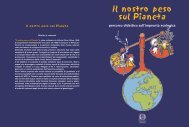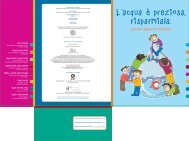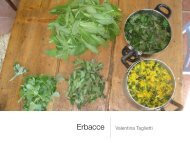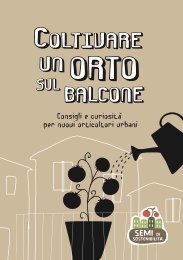Myanmar Protected Areas: Context, Current Status ... - Istituto Oikos
Myanmar Protected Areas: Context, Current Status ... - Istituto Oikos
Myanmar Protected Areas: Context, Current Status ... - Istituto Oikos
Create successful ePaper yourself
Turn your PDF publications into a flip-book with our unique Google optimized e-Paper software.
LAMPI ISLAND<br />
Site ID 17<br />
Locality Tanintharyi Region (Boke Pyin Township)<br />
Coordinates N 10° 50’, E 98° 12’<br />
Size (km²) 205<br />
Altitude (m. asl) 0 – 455<br />
<strong>Myanmar</strong> category National Park<br />
IUCN category II<br />
Site Governance Nature and Wildlife Conservation Division<br />
Boundaries Demarcated<br />
Year gazetted 1996<br />
Protection level Total<br />
Main purposes Conservation<br />
Habitat<br />
Evergreen Forest (Typical), Mangrove Forest, Beach and<br />
Dune Forest, Sea Grass Beds, Coral Reefs<br />
Key resources Coral Reefs, Mouse Deer and Salone Ethnic Groups<br />
Legend of topographic maps<br />
Head Quarters<br />
Ranger Post<br />
Towns<br />
<strong>Protected</strong> <strong>Areas</strong><br />
State/Region Boundaries<br />
Roads<br />
Water areas<br />
Rivers<br />
Elevation<br />
5.800 m. asl<br />
0 m. asl<br />
Legend of satellite maps<br />
Water Depth Vegetation Density<br />
Deep<br />
Shallow<br />
High<br />
Low<br />
SITE DESCRIPTION<br />
Lampi Island Marine National Park encompasses a section of<br />
the Myeik Archipelago including Lampi Island, several smaller<br />
islands and the seas around them. The sea between Lampi<br />
and the mainland is on average 12 m deep and nowhere<br />
deeper than 24 m. Lampi island is generally hilly and rises<br />
steeply from sea level up to 455 m. The majority of the coast is<br />
rocky, presenting also sandy beaches, bays and inlets. Lampi<br />
island has two major perennial rivers and many small seasonal<br />
streams. Lampi habitats are mostly intact, and if measures are<br />
put into place soon, the representativeness and key attributes<br />
of this vast island ecosystem can be conserved at this site.<br />
Lampi is an ASEAN heritage site, an Important Bird Area (IBA)<br />
and a designated <strong>Myanmar</strong> ecotourism site.<br />
NATURAL RESOURCES<br />
Evergreen forest is the major forest type of the site. Mangrove<br />
and beach & dune forests are also present at the site. Coral<br />
reefs fringe the islands. Seagrass beds are present especially<br />
in the east side of the island.<br />
MANAGEMENT<br />
In 2009 the MEP project initiated consultations among the<br />
different stakeholders aimed at launching the process for a<br />
participatory development of the management plan to ensure<br />
50 51<br />
THREATS<br />
• Housing & Urban <strong>Areas</strong><br />
• Fishing & Harvesting Aquatic Resources<br />
• Hunting & Collecting Terrestrial Animals<br />
• Logging & Wood Harvesting<br />
• Wood & Pulp Plantations<br />
• Garbage & Solid Waste<br />
For a detailed list see chapter 3.<br />
LAND USE<br />
• Residential (4 villages inside and 1 outside)<br />
• Industrial (fish factory in War Kyunn)<br />
• Fishing<br />
• Temporary and permanent cropping<br />
the involvement of local communities and the incorporation<br />
of their needs and aspirations. It has also supported field<br />
surveys to gather scientific data on the naturalistic and<br />
cultural features of the area, to enable participatory planning<br />
and management of natural resources.<br />
STAFF / RESOURCES<br />
The planned staff will include 25 people but none has been<br />
assigned yet.<br />
<strong>Istituto</strong> <strong>Oikos</strong> and BANCA have supported the construction of<br />
a field camp at Makyone Galet village on Bo Cho Island which<br />
is very near to the southern coast of Lampi island. The camp<br />
includes a basic office and a rest house and is equipped with<br />
1 motorboat, 3 GPS, 2 binoculars, 1 laptop, 1 printer, camping<br />
equipment, field guides.<br />
TOURISM<br />
At present there is no tourist accommodation on Lampi Island<br />
or on the other islands inside the marine national park, and<br />
visitors are not allowed to spend the night on these islands.<br />
Therefore, visitor opportunities to Lampi are limited to sailing<br />
cruises including diving opportunities. The few boats allowed<br />
to bring tourists in the Myeik Archipelago belong to <strong>Myanmar</strong><br />
or Thai companies which have license from <strong>Myanmar</strong> Ministry<br />
of Hotel and Tourism.<br />
RESEARCH<br />
<strong>Myanmar</strong> <strong>Protected</strong> <strong>Areas</strong><br />
Surveys to Lampi were conducted by FAO in 1983, WCS<br />
in 1995-96) and Ecoswiss in 2006-7. Since 2008 <strong>Istituto</strong><br />
<strong>Oikos</strong> and BANCA have been conducting field research on<br />
several topics.<br />
In the Myeik Archipelago, marine biological surveys were<br />
conducted by the Department of Botany and Zoology of<br />
Moulmein (Mawlamyine) University. The Department of<br />
Marine Science at Mawlamyine and Myeik Universities also<br />
conducted marine biological studies






